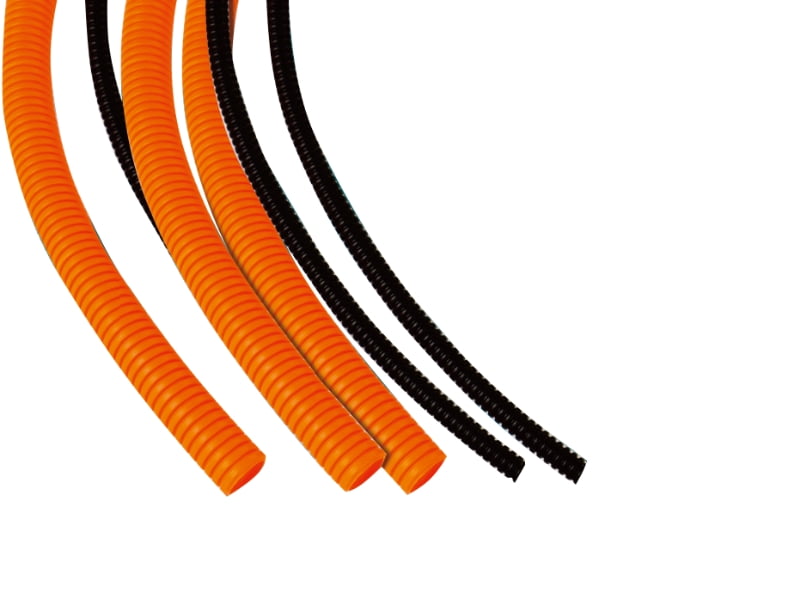コルゲートパイプとは何ですか?
コルゲートパイプは,その隆起した(波形の)外壁と滑らかな内壁を特徴とする,柔軟で軽量な配管ソリューションです。この独自の設計は,構造的な強度と柔軟性の間の最適なバランスを提供します。波形は,パイプの強度を高める一連の同心円状のリングを作成します。 フープ強度(通常,HDPEパイプの場合は50~100 psi) 柔軟性を維持しながら 最小曲げ半径はパイプ径の20倍.
標準コルゲートパイプの主な技術仕様:
材料: 高密度ポリエチレン(HDPE),ポリプロピレン(PP),またはPVC
直径範囲: 2インチ~60インチ(50mm~1500mm)
壁の厚さ: 直径と圧力定格に応じて1.5mmから15mm
温度範囲: HDPEの場合 -40°F~180°F(-40°C~82°C)
耐薬品性: ほとんどの用途で pH 範囲は 2 ~ 12
圧縮強度: 材質とプロファイルに応じて1,500~4,000 psi
コルゲートパイプの特性
コルゲートパイプの構造設計には,いくつかの明確な利点があります。
高い強度対重量比: 波形プロファイルにより慣性モーメントが増加する 300~400% 同等の重量の滑らかなパイプと比較して, 土壌耐荷重能力は最大100 kn/m².
柔軟性: 耐えられる 直径の最大10%のたわみ 構造的な損傷がなく,一時的な変形後に元の形状に戻ることができる弾性回復特性を備えています。
油圧効率: 滑らかな内部は マニングの粗度係数(n)は0.009~0.015コンクリートパイプに匹敵し,外側の波形構造により土壌とパイプの相互作用に利点をもたらします。
耐久性: HDPEコルゲートパイプは 耐用年数は100年を超える 適切な設置により,環境応力によるひび割れに抵抗し, ノッチ付き定常引張荷重(NCTL)定格 >1,500時間.
耐薬品性: 酸,アルカリ,塩に対する優れた耐性 体重の変化 <0.5% after 30 days immersion in most chemicals at 20°c.
application scenarios
corrugated pipes serve diverse applications across multiple industries:
stormwater management: used in subsurface drainage systems handling flows up to 1000 gallons per minute (3,785 l/min) in 12-inch diameter pipes at 1% slope.
agricultural drainage: perforated corrugated pipes with slot openings of 0.04-0.08 inches (1-2mm) spaced at 3-6 inch (75-150mm) intervals for subsurface irrigation and field drainage.
road and railway construction: as culvert pipes with aashto m252/m294 compliance, supporting hs20-44 loading when properly embedded.
telecommunications conduit: innerduct systems with 40-60% reduction in cable pulling tension compared to smooth bore pipes.
geothermal systems: closed-loop ground source heat pump applications with thermal conductivity of 0.42-0.51 w/m·k.
mining operations: ventilation ducts with static pressure ratings up to 5 inches wg (1,245 pa) for auxiliary mine ventilation.
maintenance procedures
proper maintenance ensures optimal performance and longevity:
inspection schedule:
quarterly visual inspections for surface damage or deformation
annual cctv inspections for interior assessment (minimum 20 lux illumination and 540 tv lines resolution)
biannual flow capacity verification using ultrasonic flow meters with ±2% accuracy
cleaning methods:
hydrojetting at 1,500-3,000 psi (10-20 mpa) with 4-8 gpm (15-30 l/min) flow rates
mechanical rodding with carbon fiber rods rated for 250 lbs (113 kg) of pushing force
for grease buildup, use ph-neutral enzymatic cleaners (6.5-7.5 ph)
repair techniques:
patch repairs using electrofusion couplings with 2,000 psi (13.8 mpa) tensile strength
cured-in-place pipe (cipp) lining with resin systems achieving 12,000 psi (83 mpa) flexural strength
section replacement following astm f2561/f2561m standard practice
preventive measures:
install sediment traps with 50 micron filtration at inlets
apply uv stabilizers (0.3-0.5% carbon black concentration) for exposed pipes
maintain minimum 12 inch (300mm) cover depth for buried pipes
critical maintenance data points:
maximum allowable deflection: 7.5% of diameter (per astm f2648)
recommended cleaning velocity: 3-5 ft/s (0.9-1.5 m/s)
acceptable ovality limit: ±5% of nominal diameter
joint pull-out resistance: ≥1,000 lbs (454 kg) for 12-inch pipes



 English
English


